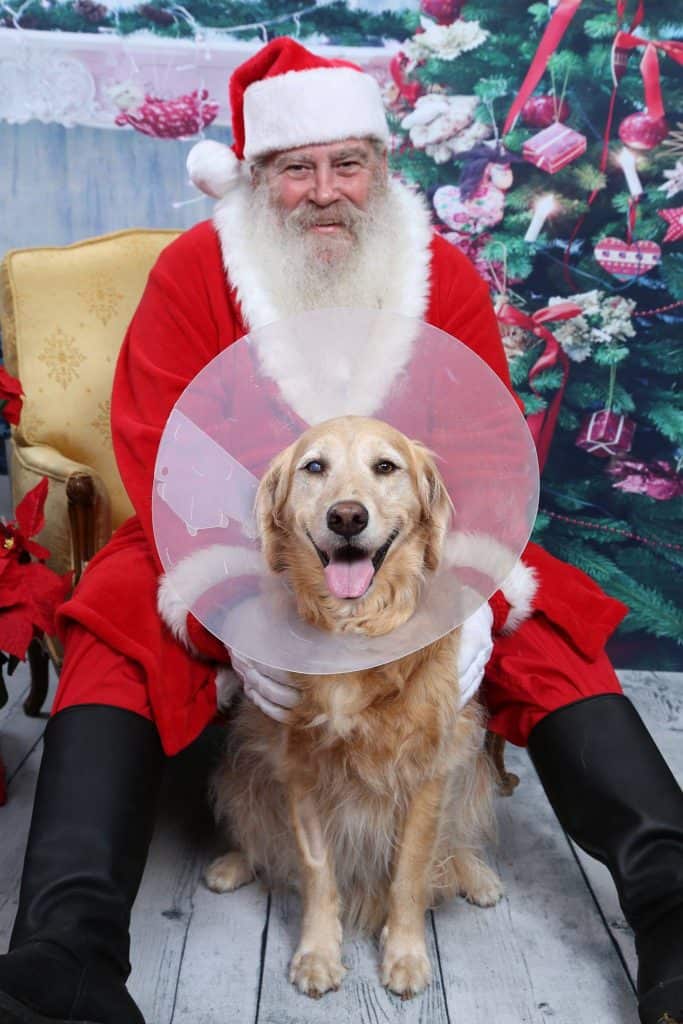“This post contains affiliate links, and I will be compensated if you make a purchase after clicking on my links.”
Winter weather is in full swing for many parts of the country and holiday decorations are starting to go up everywhere! It’s a time of togetherness, making memories, and stuffing our bellies full of tasty treats. And that includes sharing the love with our furriest family members, too!
But the holidays aren’t without their hazards. Unless a trip to the veterinary emergency room is on your holiday wish list, follow these 10 winter holiday safety tips from our friends at CareCredit to help ensure this season is your jolliest one yet:
1. O’ Christmas Tree
Your Christmas tree itself will create some curiosity for your furriest family members — so be aware of these potential dangers. Make sure your tree is very secure so it can’t topple over on top of your fur friend. Be aware that, if you have a live tree, some fallen needles could be mildly toxic. Never let your dog drink the water from your tree, as they are often sprayed with pesticides or fertilizers that can leech into the water. Any home with a pet should avoid decorating a tree with tinsel as it can very easily cause a blockage if ingested.
2. Keep Fido away from the fruitcake!
All pet parents should be aware of the “people foods” that are toxic to their pets. Make sure your dog doesn’t have access to any holiday treats that include ingredients, like raisins, grapes, macadamia nuts, chocolate, onions, or other toxic foods.
3. Give them an escape.
The holidays can be a stressful time for all of us — including our pets! For them, the stress comes from all the hustle and bustle of a holiday gathering. So if you’re going to have guests in your home, be sure you provide your furriest family with a quiet, safe place they can escape to. Be sure to tell your guests not to let the family pet escape through an open door.
4. Don’t play with fire.
Whether you’re lighting a menorah, Christmas candles, or warming your home with a crackling fireplace, always keep curious noses away from open flames. Keep candles out of reach and keep a screen in front of your fireplace.
5. Know what plants are poisonous.
So many popular holiday plants are toxic to dogs — poinsettias, holly, and mistletoe, to name a few. Any time you bring a new plant into your home, check first that it’s safe for your pup.
6. Watch out for antifreeze.
Lots of cars leak antifreeze and it is, unfortunately, very appealing to our pups. They love the taste and smell — and as little as one tablespoon of antifreeze ingested can be fatal if untreated. Always watch out for puddles of antifreeze while you’re on walks.
8. Protect the paws.
Dogs can get frostbite, particularly on their paws. Ice, snow, even frozen driveways, and sidewalks can lead to frostbite on unprotected paws. A pair of booties or some paw-protectant will go a long way toward keeping those corn-chip paws feeling fine. After walks, be sure to clean any snow, salt, or ice from their paws and between their toes. Ice melt salt used on roads and sidewalks can be highly toxic to dogs and can cause anything from mild paw irritation to acute kidney failure, so be sure your dog doesn’t ingest any of it by licking it from their paws.
9. Bundle up when temps go down.
While some breeds, like Huskies, Saint Bernards, and Malamutes are perfectly suited for freezing temperatures in their own fur coats, many dogs will be safer and more comfortable in a sweater or winter coat to protect them when they go outside. Tiny dogs, senior dogs, very young dogs, and those with illnesses or injuries should bundle up before venturing out into the cold of winter.
9. Can I see your identification?
Make sure your dog is wearing a collar and ID tags whenever he’s outside, especially in the winter. Snow and ice on the ground can mask smells, making it difficult for him to find his way back home if lost. Better yet, microchip your pets! If their collars are lost or removed, a microchip will always make it possible for your dog to be identified if found.
10. Get peace of mind with CareCredit.
Even the most cautious, caring pet parents can be faced with an accident or emergency. In fact, 4 out of 5 pets will have a medical emergency in their lifetime† — and those unexpected illnesses can cost thousands of dollars. Thankfully, having a CareCredit credit card in your pocket will give you comfort during an otherwise chaotic season.
From routine appointments to emergency situations or surgeries, the CareCredit card gives pet parents the peace of mind you need to care for your dog. Unlike traditional pet financing or veterinary payment plans, the CareCredit credit card gives you the flexibility to use your card again and again for your pet’s procedures**. So, if you use your card for an emergency, you can use it again for any follow-up appointments. You can even use it down the road for routine vaccinations if you need to.
Brandy Arnold, Editor of The Dogington Post wanted to share her own experience with CareCredit:
It was a beautiful late fall afternoon in Florida, one of those rare days you could open all the windows and let the breeze in—and my dogs were loving it, too. I’d propped open the back door, so Olive, my Golden Retriever, could go in and out between the house and the fenced backyard as often as she pleased, which had been about a million times that day. Late that afternoon, I heard Olive barking frantically and rushed outside to find her face-to-beak with an anhinga that had landed in the backyard. Anhingas are large water birds, sometimes called “snake birds” for their long, slender neck that sticks above the water when they swim, resembling a snake dancing on the surface. Their beaks are long, narrow, and sharp, used for spearing the unfortunate fish that cross their path. That day, however, it was Olive who’d found herself face to face with a feisty bird who’d somehow found his way into her yard.

When I brought Olive back inside, I realized she was holding her right eye closed. I loaded Olive in the car and rushed to the veterinarian. I was prepared for the occasional accident or emergency—with two large dogs, two cats, and an iguana at home, I knew the importance of keeping some savings aside in case of an emergency. But, I wasn’t prepared for this. Within just minutes, we were referred to a veterinary ophthalmologist for emergency surgery. As it turned out, the anhinga had speared Olive’s eye with its dagger-like beak. Surgery was the only option. Without it, she was suffering, in pain, and at risk for serious infection and death. I used the entirety of my emergency fund to pay the deposit to begin repairing her eye, not knowing how I would come up with the remaining $4500 owed when I returned to pick her up the following day. Then I remembered CareCredit. Within just a few minutes, I had been approved for the entire amount I needed, including enough to cover medications and follow-up visits for the next several months, and it was available to use right away. Without CareCredit, I might not have my best friend by my side today…., she’s a happy, healthy senior that you’d never know was blind in one eye from her face-off with the wayward bird.
Watch how the CareCredit credit card was there for Ann when she needed veterinary financing for emergency vet services for her Husky, Taylor:
With these cold-weather precautions and holiday preparations in place, you and your dog can have a wonderful winter!
†Pets Best claims data 2015–3/31/2020 for unexpected medical care.
**Subject to credit approval.*
The content is subject to change without notice and provided solely for your convenience. You are urged to consult with your individual advisors with respect to any information presented. Neither Synchrony nor any of its affiliates, including CareCredit, make any representations or warranties regarding this content and accepts no liability for any loss or harm arising from the use of the information provided.



















